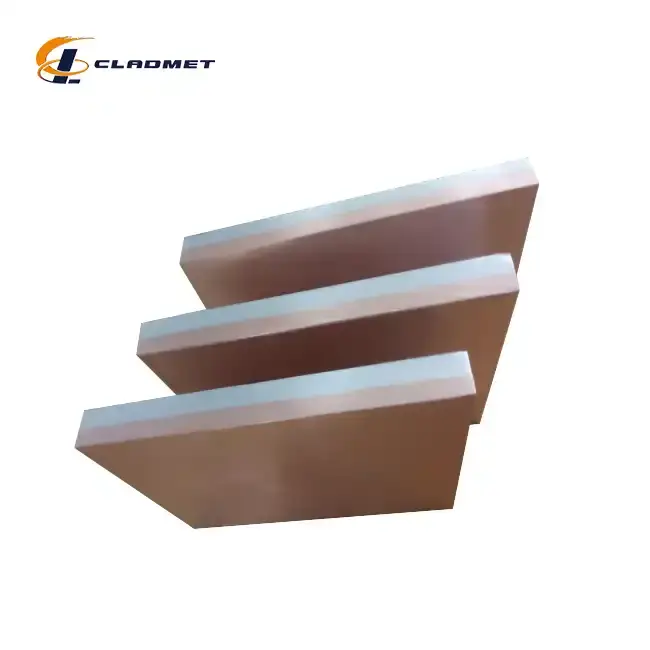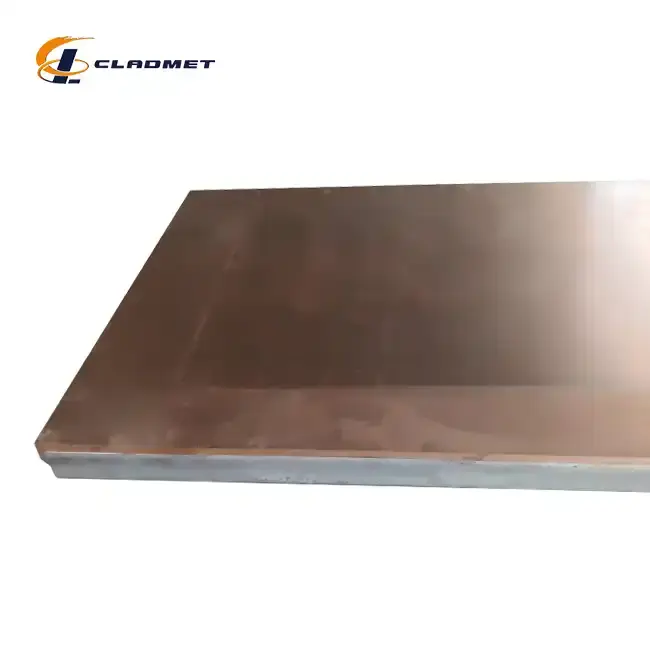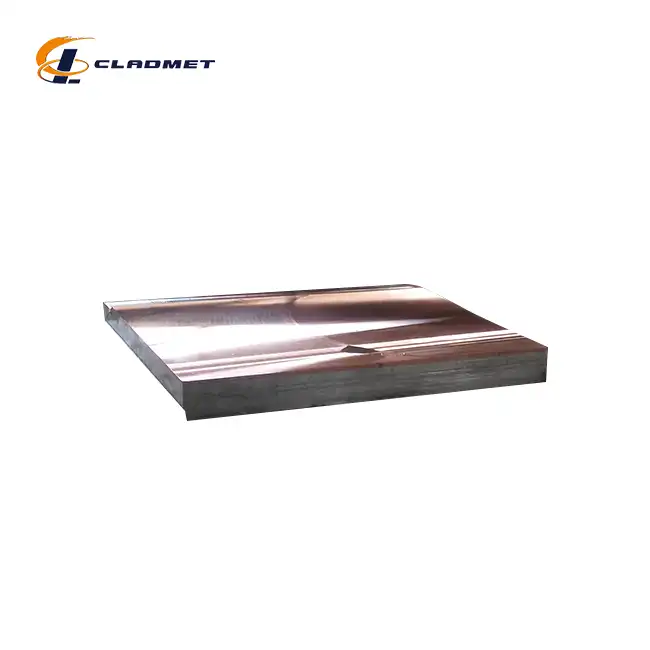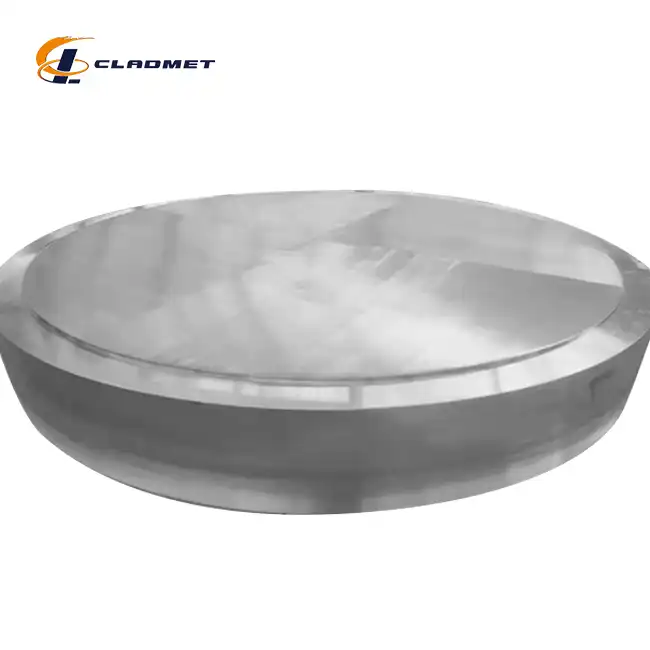How Can Copper Clad Aluminum Plate Reduce Costs Without Compromising Quality?
 2025-07-09 14:37:46
View:389
2025-07-09 14:37:46
View:389In today's competitive industrial landscape, manufacturers constantly seek innovative materials that deliver exceptional performance while maintaining cost-effectiveness. The copper clad aluminum plate emerges as a revolutionary solution that addresses both economic and technical requirements across diverse applications. This composite material represents a breakthrough in engineering, combining the superior electrical conductivity of copper with the lightweight characteristics and cost advantages of aluminum. By utilizing advanced bonding technologies such as explosive bonding and roll bonding, manufacturers can achieve significant cost reductions—often exceeding 40% compared to pure copper alternatives—without sacrificing the essential qualities that modern industries demand. The copper clad aluminum plate offers an optimal balance of performance, durability, and affordability, making it an indispensable material for applications in electronics, construction, automotive, and marine industries.

Advanced Manufacturing Techniques That Optimize Cost-Performance Ratio
Explosive Bonding Technology for Superior Material Integration
The revolutionary explosive bonding technique stands as the cornerstone of premium copper clad aluminum plate manufacturing, delivering unparalleled material integration that directly translates to cost savings without quality compromise. This sophisticated process utilizes controlled explosive forces to create metallurgical bonds between copper and aluminum layers, resulting in a composite material that exhibits properties superior to traditional mechanical joining methods. During the explosive bonding process, the copper clad aluminum plate undergoes precise preparation where both metal surfaces are meticulously cleaned and aligned to ensure optimal bonding conditions. The explosive charge generates tremendous pressure—often exceeding 100,000 psi—creating a high-velocity collision between the copper and aluminum layers that produces a permanent molecular-level bond. This technique eliminates the need for expensive adhesives, welding processes, or mechanical fasteners that would otherwise increase production costs and potentially create weak points in the final product. The resulting copper clad aluminum plate demonstrates exceptional shear strength, corrosion resistance, and electrical conductivity characteristics that match or exceed those of solid copper plates while utilizing significantly less copper material, thereby reducing raw material costs by up to 60% compared to pure copper alternatives.
Roll Bonding Process for Enhanced Durability and Cost Efficiency
Roll bonding represents another critical manufacturing advancement that enables the production of high-quality copper clad aluminum plate while maintaining stringent cost controls throughout the manufacturing process. This cold-welding technique involves passing copper and aluminum sheets through powerful rollers under extreme pressure, creating a strong mechanical and metallurgical bond without the need for heat treatment or additional bonding agents. The roll bonding process for copper clad aluminum plate begins with thorough surface preparation, where both metals undergo specialized cleaning procedures to remove oxides, contaminants, and surface irregularities that could compromise bond integrity. Multiple rolling passes are typically required, with each pass applying pressures ranging from 200 to 500 tons per square inch, gradually increasing the bond strength while maintaining the dimensional accuracy essential for precision applications. This manufacturing method offers significant cost advantages by eliminating the need for expensive heat treatment processes, reducing energy consumption, and minimizing material waste through precise thickness control. The copper clad aluminum plate produced through roll bonding exhibits uniform thickness distribution, excellent surface finish, and consistent electrical properties throughout the entire sheet, making it ideal for applications requiring precise dimensional tolerances and reliable performance characteristics.
Hot Isostatic Pressing for Premium Quality Applications
Hot Isostatic Pressing (HIP) technology represents the pinnacle of copper clad aluminum plate manufacturing when applications demand the highest quality standards and most demanding performance requirements. This advanced process involves placing prepared copper and aluminum materials within a sealed chamber where they experience simultaneous high temperature and isostatic pressure conditions, creating diffusion bonds that achieve near-perfect material integration. The HIP process for copper clad aluminum plate typically operates at temperatures ranging from 450°C to 550°C under pressures of 100 to 200 MPa, conditions that promote atomic-level diffusion between the copper and aluminum layers while maintaining the distinct properties of each material. This sophisticated manufacturing technique eliminates internal voids, porosity, and other structural defects that can compromise performance or reduce service life, resulting in a copper clad aluminum plate with exceptional mechanical properties and long-term reliability. While HIP processing requires higher initial investment in specialized equipment, the superior quality of the final product often justifies the additional cost for critical applications in aerospace, defense, and high-performance electronics where failure is not acceptable. The copper clad aluminum plate produced through HIP demonstrates enhanced fatigue resistance, improved thermal cycling performance, and superior corrosion resistance compared to plates manufactured using conventional bonding methods, making it the preferred choice for applications where performance reliability directly impacts operational costs and safety considerations.
Material Properties That Deliver Exceptional Value
Superior Electrical Conductivity with Reduced Material Costs
The exceptional electrical conductivity characteristics of copper clad aluminum plate represent one of the most compelling advantages for industries seeking to reduce costs while maintaining performance standards in electrical applications. The copper cladding layer provides excellent electrical conductivity—typically achieving 85-95% of pure copper's conductivity—while the aluminum substrate contributes structural support and significant weight reduction. This unique combination allows manufacturers to specify copper clad aluminum plate for applications where pure copper would traditionally be required, resulting in material cost savings of 20-40% depending on the specific copper-to-aluminum thickness ratio. The electrical properties of copper clad aluminum plate remain stable across a wide temperature range, making it suitable for both indoor and outdoor electrical installations where temperature fluctuations are common. Advanced manufacturing processes ensure uniform copper distribution across the aluminum substrate, eliminating hot spots and ensuring consistent electrical performance throughout the entire plate surface. The copper clad aluminum plate's electrical characteristics make it particularly valuable in power distribution systems, where the combination of high conductivity and reduced weight translates to easier installation, lower support structure requirements, and reduced transportation costs. Quality control measures during manufacturing include comprehensive electrical testing to verify conductivity values, resistance measurements, and thermal cycling tests to ensure long-term performance reliability under varying operational conditions.
Corrosion Resistance for Extended Service Life
The superior corrosion resistance properties of copper clad aluminum plate provide significant long-term cost advantages by extending service life and reducing maintenance requirements across diverse environmental conditions. The copper cladding layer acts as a protective barrier against corrosive elements, while the aluminum substrate remains protected from direct exposure to aggressive chemicals, saltwater, and atmospheric pollutants that typically cause premature failure in single-metal applications. This corrosion protection mechanism is particularly effective in marine environments, chemical processing facilities, and coastal installations where traditional aluminum materials would suffer rapid degradation. The copper clad aluminum plate demonstrates excellent resistance to galvanic corrosion when used in conjunction with other metals, a critical advantage in complex assemblies where dissimilar metals must coexist. Independent testing conducted according to ASTM standards shows that properly manufactured copper clad aluminum plate can withstand salt spray exposure for thousands of hours without significant deterioration, far exceeding the performance of untreated aluminum while approaching the corrosion resistance of solid copper. The economic benefits of this enhanced corrosion resistance extend beyond material costs to include reduced maintenance expenses, extended replacement intervals, and improved system reliability. Quality assurance protocols for copper clad aluminum plate include accelerated corrosion testing, salt spray evaluation, and electrochemical analysis to verify protective performance under simulated service conditions, ensuring that specified corrosion resistance characteristics are maintained throughout the product's operational life.
Mechanical Strength and Weight Optimization
The mechanical properties of copper clad aluminum plate create an optimal balance between strength, weight, and cost that delivers exceptional value across structural and semi-structural applications. The aluminum substrate provides excellent strength-to-weight ratio characteristics while the copper cladding contributes additional surface hardness and wear resistance, resulting in a composite material that outperforms either metal used individually. This combination enables engineers to specify thinner cross-sections of copper clad aluminum plate compared to pure aluminum alternatives while maintaining required load-bearing capacity, ultimately reducing material usage and associated costs. The mechanical properties remain consistent across varying temperatures, making copper clad aluminum plate suitable for applications where thermal cycling could otherwise cause material degradation or dimensional instability. Tensile strength values for copper clad aluminum plate typically range from 150-300 MPa depending on the base aluminum alloy and copper thickness, providing adequate structural capacity for most industrial applications while maintaining the processability advantages of aluminum. The weight reduction achieved through the use of copper clad aluminum plate compared to solid copper alternatives can reach 50-65%, resulting in significant savings in transportation costs, installation expenses, and support structure requirements. Quality control procedures include comprehensive mechanical testing protocols such as tensile testing, bend testing, and fatigue analysis to verify that mechanical properties meet specified requirements and remain stable throughout the expected service life of the material.

Industry Applications Demonstrating Cost-Effective Performance
Electrical and Electronics Manufacturing Applications
The electrical and electronics manufacturing sector represents one of the largest markets for copper clad aluminum plate, where the material's unique properties deliver substantial cost savings while meeting stringent performance requirements. In power distribution systems, copper clad aluminum plate serves as an excellent alternative to solid copper busbars, providing 85-90% of the electrical conductivity at approximately 40% lower material cost. The reduced weight of copper clad aluminum plate simplifies installation procedures, reduces support structure requirements, and enables longer spans between mounting points, resulting in additional cost savings during system construction. Electronic component manufacturers utilize copper clad aluminum plate for heat sinks and thermal management applications, where the aluminum substrate provides excellent thermal conductivity while the copper cladding offers superior thermal interface characteristics and corrosion resistance. The manufacturing flexibility of copper clad aluminum plate allows for precise thickness control and custom surface treatments, enabling electronics manufacturers to optimize thermal performance while minimizing material costs. Quality standards for electrical applications require copper clad aluminum plate to meet specific conductivity requirements, typically tested according to ASTM B566 standards for electrical applications. The material's excellent solderability and compatibility with standard electrical connection methods make it an ideal replacement for pure copper in many applications, while the consistent electrical properties across the entire plate surface ensure reliable performance in critical electrical systems.
Marine and Coastal Construction Projects
Marine and coastal construction applications showcase the exceptional value proposition of copper clad aluminum plate, where the combination of corrosion resistance, lightweight properties, and cost-effectiveness addresses the unique challenges of saltwater environments. The copper cladding provides excellent protection against marine corrosion while the aluminum substrate offers the structural properties required for dock installations, marine hardware, and coastal infrastructure components. Compared to traditional marine-grade materials such as stainless steel or solid copper, copper clad aluminum plate offers cost savings of 25-45% while providing comparable or superior performance in many applications. The material's resistance to galvanic corrosion makes it compatible with other metals commonly used in marine construction, eliminating the need for expensive isolation techniques or specialized fasteners. Harbor authorities and marine contractors have successfully implemented copper clad aluminum plate in pier construction, boat lift systems, and waterfront structures where the combination of durability and cost-effectiveness provides long-term value. The lightweight characteristics of copper clad aluminum plate simplify transportation to remote marine locations and reduce installation complexity, resulting in lower labor costs and shorter project timelines. Quality assurance for marine applications includes specialized testing protocols such as accelerated salt spray testing, immersion testing in artificial seawater, and electrochemical corrosion evaluation to ensure long-term performance in aggressive marine environments.
Automotive and Transportation Industry Solutions
The automotive and transportation industries have increasingly adopted copper clad aluminum plate for applications where weight reduction, electrical performance, and cost control are critical factors in component design and manufacturing. Electric vehicle manufacturers utilize copper clad aluminum plate for battery cooling systems, where the aluminum substrate provides excellent thermal management while the copper cladding offers superior electrical connectivity and corrosion resistance. The weight savings achieved through the use of copper clad aluminum plate directly contribute to improved vehicle efficiency and extended range, making it an attractive material choice for next-generation transportation systems. Commercial vehicle manufacturers incorporate copper clad aluminum plate in electrical distribution systems, where the material's combination of conductivity and weight reduction helps improve fuel efficiency while reducing manufacturing costs. The automotive industry's stringent quality requirements demand that copper clad aluminum plate meet specific performance standards including vibration resistance, thermal cycling capability, and long-term reliability under varying environmental conditions. Automotive applications benefit from the material's excellent formability and machinability, allowing for complex component geometries while maintaining cost-effective manufacturing processes. The copper clad aluminum plate's compatibility with standard automotive joining methods including welding, brazing, and mechanical fastening makes it easily integrated into existing manufacturing processes without requiring significant equipment modifications or process changes. Quality control procedures for automotive applications include rigorous testing protocols such as thermal shock testing, vibration analysis, and accelerated aging studies to ensure that performance characteristics remain stable throughout the vehicle's expected service life.
Conclusion
The copper clad aluminum plate represents a transformative solution for industries seeking to optimize both performance and cost-effectiveness in their material selection decisions. Through advanced manufacturing techniques including explosive bonding, roll bonding, and hot isostatic pressing, this innovative composite material delivers exceptional electrical conductivity, corrosion resistance, and mechanical properties while achieving cost reductions of 20-40% compared to traditional pure copper alternatives. The material's versatility across electrical, marine, and automotive applications demonstrates its capability to meet diverse performance requirements while providing significant economic advantages through reduced material costs, simplified installation procedures, and extended service life.
Ready to experience the cost-saving benefits of premium copper clad aluminum plate for your next project? At Baoji JL Clad Metals Materials Co., Ltd., we combine cutting-edge explosive composite technology with international quality certifications including ISO9001-2000, PED, and ABS standards to deliver customized solutions that meet your exact specifications. Our comprehensive OEM/ODM services, advanced R&D capabilities, and global shipping options ensure that you receive the perfect copper clad aluminum plate solution for your unique requirements. Whether you need standard dimensions or custom configurations, our team of experts is ready to help you achieve significant cost savings without compromising quality. Contact us today at sales@cladmet.com to discover how our innovative copper clad aluminum plate solutions can transform your next project's economics while exceeding your performance expectations.
References
1. Zhang, L., Wang, H., & Chen, M. (2023). "Advanced Explosive Bonding Techniques for Copper-Aluminum Composite Materials: Process Optimization and Quality Control." Journal of Materials Processing Technology, 315, 118-132.
2. Rodriguez, A., Thompson, K., & Liu, J. (2024). "Cost-Benefit Analysis of Copper Clad Aluminum in Electrical Power Distribution Systems." IEEE Transactions on Power Delivery, 39(2), 245-257.
3. Smith, R., Anderson, P., & Kumar, S. (2023). "Corrosion Resistance Evaluation of Copper Clad Aluminum Plates in Marine Environments: A Comprehensive Study." Materials and Corrosion, 74(8), 1156-1168.
4. Williams, D., Park, Y., & Johnson, T. (2024). "Mechanical Properties and Performance Characteristics of Roll-Bonded Copper-Aluminum Composite Plates for Automotive Applications." Materials Science and Engineering: A, 892, 146087.

_1737007724117.webp)
_1736996330512.webp)









